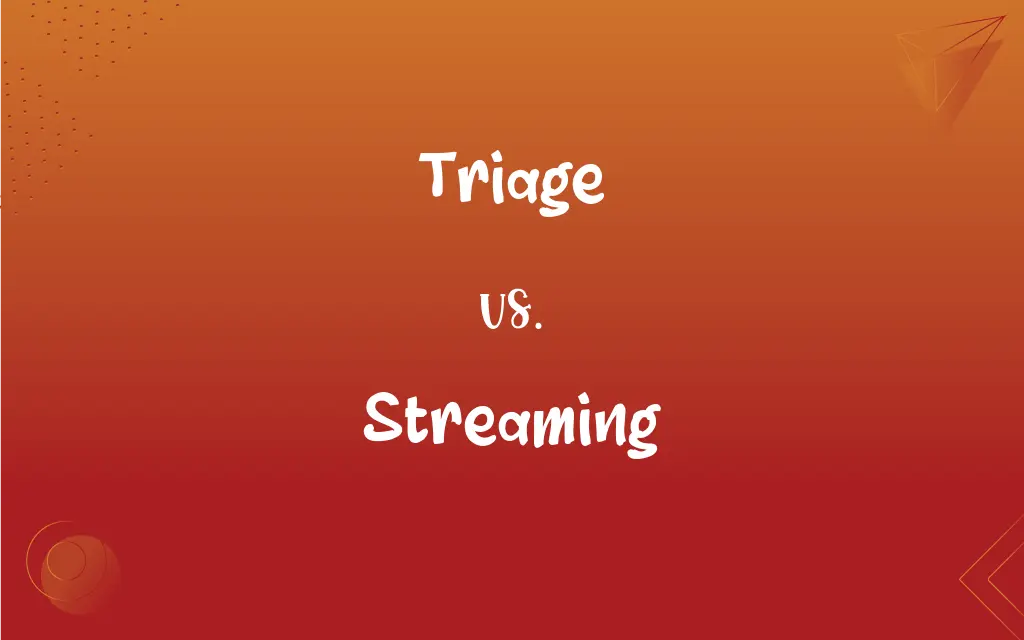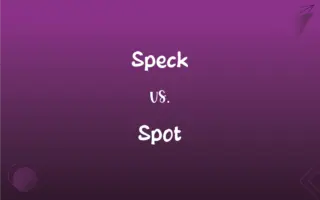Triage vs. Streaming: What's the Difference?
By Harlon Moss & Janet White || Updated on May 22, 2024
Triage involves prioritizing patients based on urgency in medical settings, while streaming refers to the continuous transmission of data over the internet, commonly used for media consumption.

Key Differences
Triage is a process used in medical and emergency settings to prioritize patient care based on the severity of their condition. It ensures that those who need immediate attention receive it first. Streaming, on the other hand, involves the real-time transmission of data, especially for video and audio content, allowing users to access media without downloading files completely beforehand.
Triage is critical in scenarios where resources are limited, such as during mass casualty events, where it helps allocate medical attention efficiently. Whereas, streaming technology is pivotal in the entertainment and communication industries, enabling services like Netflix and live broadcasts.
In healthcare, triage is often performed by medical professionals who assess patients' symptoms to determine treatment order. In contrast, streaming relies on servers and internet connectivity to deliver content to users in a seamless flow.
While triage is focused on immediate physical health outcomes, streaming enhances user experience by providing instant access to digital content. Both involve managing resources effectively, but triage deals with human resources and patient care, whereas streaming deals with digital bandwidth and media delivery.
Comparison Chart
Definition
Prioritizing patients based on urgency
Continuous transmission of data
ADVERTISEMENT
Context
Medical and emergency settings
Media consumption and communication
Main Purpose
Efficient patient care
Instant access to content
Process Involves
Medical professionals
Servers and internet connectivity
Resource Management
Human resources and medical attention
Digital bandwidth and data flow
Triage and Streaming Definitions
Triage
A system used to allocate limited medical resources effectively.
During a disaster, triage helps manage the influx of injured individuals.
ADVERTISEMENT
Streaming
The real-time transmission of audio and video over the internet.
Streaming services like Netflix provide on-demand movies.
Triage
The process of evaluating situations to prioritize actions.
Firefighters performed triage to determine the most pressing fires to extinguish.
Streaming
A method of accessing media without downloading it.
Many people prefer streaming music rather than downloading tracks.
Triage
An assessment method to determine the order of treatment.
Triage protocols are essential in military field hospitals.
Streaming
A flow of water in a channel or bed, as a brook, rivulet, or small river.
Triage
The process of determining the priority of patients' treatments based on the severity of their condition.
In an emergency room, triage ensures that critical patients are treated first.
Streaming
A steady current in such a flow of water.
Triage
The action of sorting patients into categories based on urgency.
The triage nurse assessed the patient's symptoms quickly.
Streaming
A steady current of a fluid.
Triage
A process for sorting injured people into groups based on their need for or likely benefit from immediate medical treatment. Triage is used in hospital emergency rooms, on battlefields, and at disaster sites when limited medical resources must be allocated.
Streaming
A large amount or number moving or occurring in steady succession
A stream of commuters.
A stream of insults.
Triage
A system used to allocate a scarce commodity, such as food, only to those capable of deriving the greatest benefit from it.
Streaming
A trend, course, or drift, as of opinion, thought, or history.
Triage
A process in which things are ranked in terms of importance or priority
"For millions of Americans, each week becomes a stressful triage between work and home that leaves them feeling guilty, exhausted and angry" (Jill Smolowe).
Streaming
A beam or ray of light.
Triage
To sort or allocate by triage
Triaged the patients according to their symptoms.
Streaming
Chiefly British A course of study to which students are tracked.
Triage
Assessment or sorting according to quality, need, etc., especially to determine how resources will be allocated.
Streaming
(Computers) A steady flow of data.
Triage
(medicine) The process of sorting patients so as to determine the order in which they will be treated (for example, by assigning precedence according to the urgency of illness or injury).
Streaming
To flow in a stream or current.
Triage
The process of prioritizing bugs to be fixed.
Streaming
To pour forth or give off a stream; flow
My eyes were streaming with tears.
Triage
That which is picked out, especially broken coffee beans.
Streaming
To move or arrive in large numbers; pour
Traffic was streaming by. Fan mail streamed in.
Triage
A marshalling yard, classification yard.
Streaming
To extend, wave, or float outward
The banner streamed in the breeze.
Triage
To subject to triage; to prioritize.
Streaming
To leave a continuous trail of light.
Triage
Sorting and allocating aid on the basis of need for or likely benefit from medical treatment or food
Streaming
To give forth a continuous stream of light rays or beams; shine.
Streaming
To emit, discharge, or exude (a body fluid, for example).
Streaming
(Computers) To transmit or receive (audio or video content), especially over the internet, in small, sequential packets that permit the content to be played continuously as it is being received and without saving it to a hard disk.
Streaming
Flowing or moving in continuous succession, like fluid in a stream.
Streaming
Present participle of stream
Streaming
Movement as a stream.
Streaming
(computing) The transmission of digital audio or video, or the reception or playback of such data without first storing it.
Streaming
Division of classes into academic streams.
Streaming
The working of alluvial deposits to get ore.
Streaming
Sending forth streams.
Streaming
The act or operation of that which streams; the act of that which sends forth, or which runs in, streams.
Streaming
The reduction of stream tin; also, the search for stream tin.
Streaming
The rapid flow of cytoplasm within a cell; - called also protoplasmic streaming.
Streaming
The circulation of cytoplasm within a cell
Streaming
Exuding a bodily fluid in profuse amounts;
His streaming face
Her streaming eyes
Streaming
Moving smoothly and continuously;
Crowds flowing through the canyons of the streets
Fan streaming into the concert hall
Streaming
(of liquids) moving freely;
A flowing brook
Streaming
Delivering continuous data flow to users.
Streaming allows viewers to watch live events without delay.
Streaming
The technology behind live broadcasts and online videos.
Streaming makes it possible to share live gameplay on platforms like Twitch.
Streaming
A process that ensures data is sent and received smoothly over networks.
Good internet speed is crucial for high-quality streaming.
FAQs
What is triage?
Triage is the process of prioritizing patient treatment based on the severity of their condition.
What are examples of streaming services?
Examples include Netflix, Spotify, and YouTube.
Why is triage important in emergencies?
Triage ensures that the most critical patients receive immediate attention, improving survival rates.
What does streaming mean?
Streaming refers to the continuous transmission of audio or video data over the internet.
Where is triage commonly used?
Triage is commonly used in emergency rooms, disaster sites, and battlefield hospitals.
Who performs triage in hospitals?
Triage is usually performed by trained medical professionals, such as nurses or doctors.
What is the goal of triage?
The goal of triage is to maximize the number of survivors by ensuring timely treatment.
What are the benefits of streaming?
Streaming provides instant access to media without the need to download large files.
How does streaming work?
Streaming works by sending data in small packets that are played immediately upon arrival.
Can triage be used outside of healthcare?
Yes, triage can be applied to any situation requiring prioritization, such as in disaster management.
What are the steps in triage?
The steps include assessment, categorization, and prioritization of patients based on their condition.
Are there different types of streaming?
Yes, including live streaming, on-demand streaming, and adaptive streaming.
What skills are needed for effective triage?
Effective triage requires quick decision-making, medical knowledge, and the ability to stay calm under pressure.
What factors affect streaming quality?
Factors include internet speed, server capacity, and the device being used.
What role does technology play in triage?
Technology can assist with triage through electronic health records and decision-support tools.
What is buffering in streaming?
Buffering is the process of preloading data to ensure smooth playback during streaming.
Can streaming be used for live events?
Yes, live streaming allows real-time broadcasting of events such as sports or concerts.
Is streaming dependent on internet speed?
Yes, higher internet speeds provide smoother and higher-quality streaming experiences.
Can you stream on any device?
Most modern devices with internet access can support streaming, including smartphones, tablets, and smart TVs.
How does triage differ from regular patient care?
Triage specifically involves prioritizing patients quickly in high-pressure situations.
About Author
Written by
Harlon MossHarlon is a seasoned quality moderator and accomplished content writer for Difference Wiki. An alumnus of the prestigious University of California, he earned his degree in Computer Science. Leveraging his academic background, Harlon brings a meticulous and informed perspective to his work, ensuring content accuracy and excellence.
Co-written by
Janet WhiteJanet White has been an esteemed writer and blogger for Difference Wiki. Holding a Master's degree in Science and Medical Journalism from the prestigious Boston University, she has consistently demonstrated her expertise and passion for her field. When she's not immersed in her work, Janet relishes her time exercising, delving into a good book, and cherishing moments with friends and family.































































